
|
![]()
Greatest Films of the 1920s
1920 | 1921 | 1922 | 1923 | 1924 | 1925 | 1926 | 1927 | 1928 | 1929
Title Screen Film Genre(s), Title, Year, (Country), Length, Director, Description 
Alibi (1929), 83 or 91 minutes, D: Roland West
An important Best Picture nominee, that blended the German expressionist style of the 1920s with the American gangster melodrama, and was noted for the Art Deco sets of famed production/art designer William Cameron Menzies. It was hailed as the first expressionistic crime film. In the cops vs. crooks story based on the long-running Broadway 1927 play Nightstick, an ex-convict and slick prohibition gangster, Chick Williams (Chester Morris) - after being released from prison, rejoined his mob. He romanced the police chief's rebellious yet naive good-girl daughter Joan Manning (Eleanor Griffith) and married her. Her father was the gruff and determined Police Sgt. Pete Manning (Purnell B. Pratt) who had allegedly framed Chick and put him away. During a warehouse heist, Chick cold-bloodedly killed beat patrol officer O'Brien (DeWitt Jennings), and used his wife's alibi to escape prosecution. During the investigation of the case, Chick also murdered undercover cop Danny McGann (Regis Toomey) posing as a perpetually-drunk Wall Street broker, leading to his lengthy death scene. Both sides of the law were portrayed as corrupt and lacked a moral center. A silent version was released simultaneously with the talkie version.


Applause (1929), 80 minutes, D: Rouben Mamoulian
Rouben Mamoulian's first film did creative and revolutionary things with recorded sound. It was a liberating, innovative breakthrough film at a time of 'static' and stultified film-making with bulky immobile cameras on sound stages. He introduced revolutionary camera techniques (including rhythmically moving and inventive shots, and the use of two cameras at the same time) and experiments with sound (use of overlapping or interlacing soundtracks, sound cues, auditory montages, and background noise). Also it had interesting, unusual, and revolutionary camera angles (from above and below) including a triangulated shot showing two simultaneous actions, the first innovative use of background sound, and it was the first film made with a two-channel or two-track monophonic mix. The film was the story of Kitty Darling (Helen Morgan), a fading and "washed-up," 1920s Broadway and nightclub burlesque singing star. As a boozing, aging, self-sacrificing mother, she attempted to shelter and save her secluded, convent-raised, grown-up 17 year-old daughter April (Joan Peers) from more experienced and manipulative characters. Despondent in the film's heartbreaking ending, Kitty suicidally poisoned herself and slowly died in her dressing room. April vowed to take her mother's place by forcing herself to go out and dance sordid burlesque in front of leering, middle-aged men. She soon realized, however, that her needs were not met with audience applause, so she left the stage to marry a nice young man who had been courting her.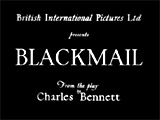


Blackmail (1929, UK), 96 minutes, D: Alfred Hitchcock
This was Hitchcock's first sound film (and the UK's first full-length talking picture) - although it was originally made as a silent picture (and simultaneously as a sound film) - with some vocal dubbing. It featured one of the director's earliest cameo appearances - a custom that would become a regular feature of his films (and the films of many others). Young and flirtatious Alice White (Anny Ondra), the daughter of a tobacco shopkeeper in 1920's London, killed over-zealous admirer Mr. Crewe (Cyril Ritchard) with a large bread knife when he sexually assaulted her in his artist's attic studio. She became guilt-ridden and fearful as her boyfriend Frank Webber (John Longden), an up-and-coming detective at Scotland Yard, pursued the case (and knew she was the assailant after finding her glove at the scene) - while blackmail was threatened by opportunistic wanted criminal Tracy (Donald Calthrop). Alice and Frank schemed to pin the rap on the blackmailer, and the film concluded with a suspenseful, climactic chase sequence after Tracy in the British Museum.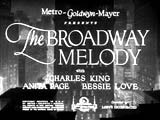

The Broadway Melody (1929), 104 minutes, D: Harry Beaumont
Hollywood released its first original (backstage) musical - it was MGM's first full-length musical feature, advertised as "all-talking, all-singing, all dancing." The musical film genre was born with the coming of sound films. It was the first, widely-distributed sound film and first musical (with an original score) to win an Oscar for Best Picture for 1928-9. This film was used as the model for all future backstage film musicals - a series of Broadway Melody sequels that stretched out to 1940 (the final film starred Fred Astaire and Eleanor Powell). With memorable songs including "Give My Regards to Broadway," "You Were Meant For Me," and "Wedding of the Painted Doll" (in two-color Technicolor), beginning a trend for other musicals to include color sequences. The film was the story of two sisters, "Hank" Mahoney and Queenie (Bessie Love and Anita Page) from Midwestern "sticks," a song-and-dance vaudeville team who were searching for stardom on Broadway, and the love triangle that developed with amorous songwriter Eddie Kerns (Charles King).

Un Chien Andalou (1929, Fr.) (aka An Andalusian Dog), 16 minutes, D: Luis Bunuel
This shocking, and provocative surrealistic film (one of the first) of the 1920s avant-garde movement, only about 16 minutes long, was filled with irrational, freely-associated and shocking images without any sense of logical continuity or narrative. It was banned in various countries, mostly for its infamous eyeball razor-slashing scene in the opening. After a title card reading: "Once upon a time," a middle-aged "husband" (Luis Buñuel) sharpened his razor and then held his "wife" (Simone Mareuil) as he slit her eye with the cutting instrument. [Note: a dead calf's eye was cut in the scene.] The sequence was intercut with shots, viewed from the balcony, of the full moon as it was sliced or bisected by clouds. Other shocking elements: the image of ants coming out of a hole in a man's hand, the dismembered hand lying in the street, and a decomposed horse on a grand piano.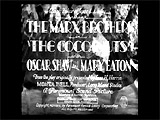

The Cocoanuts (1929), 93 minutes, D: Robert Florey & Joseph Santley
Advertised as Paramount's All Talking-Singing Musical Comedy Hit! And it was the feature film debut of the zany Marx Brothers, filmed at the Astoria studios on Long Island. It was based on their 1925 stage hit by George S. Kaufman and scripted by Morrie Ryskind. Groucho plays a Miami, Florida hotel manager/owner, Mr. Hammer, with Chico and Harpo (as themselves) as con men who fleeced guests, and Margaret Dumont as the only paying guest, socialite Mrs. Potter, in the rundown hotel - the target of jewel thieves. The plot hinging on a Florida real-estate development scheme was less significant than the wisecracks and antics of the Marx Brothers, including some classic scenes (the rigged auction scene and the "Why a Duck?" (or viaduct) routine) and Harpo's first horn-honking. Noted as the film with the first overhead camera shot, often repeated as kaleidoscopic patterns in Busby Berkeley's films in the near future.

Coquette (1929), 76 minutes, D: Sam Taylor
Silent star Mary Pickford (Best Actress winner for her first talkie, and the first talkie winner of an Academy Award) revamped her screen persona as a goody-goody - creating a pattern for women's films in the future. Set in the American South, Pickford took the role of Southern belle Norma Besant, a flirtatious college girl, and daughter of wealthy Southern doctor John Besant (John St. Polis). She was romantically involved with hot-tempered Michael Jeffery (Johnny Mack Brown) - compromised according to her father because he was a man beneath her social status. To prove himself, Michael left for six months to earn a living, but returned early. Dr. Besant confronted Michael and shot him to death, witnessed by Norma who faced a difficult choice - tell the truth, or save her father by lying. In the climactic courtroom scene, Dr. Besant implored the judge to ignore his tormented daughter's perjured testimony, confessed his murderous deed, and shot himself to death. The melodramatic film - and Pickford's Academy Award win for her overwrought performance (and strange accent) have been appropriately ridiculed, and shortly after a few more films, she was retired from film-making.

Disraeli (1929), 87/90 minutes, D: Alfred E. Green
An historical, stage-bound and stiff biopic about the British prime minister (of Jewish descent) Benjamin Disraeli (Best Actor winning George Arliss in his talkie film debut) of the 1860s-70s, and leader of the Conservative party of British Tories, who outwitted the Russians in a struggle over the purchase of the Suez Canal from Egypt, and prevented their access to British India. During the time of Victorian England, the politically-shrewd, scheming, skillful and tricky Disraeli led efforts to expand colonial policies and imperialist ventures. The historical film (though fictionalized and not entirely accurate) was previously produced as a silent film earlier in the decade as Disraeli (1921), also starring George Arliss.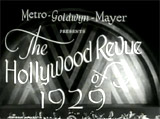
The Hollywood Revue of 1929 (1929), 118/130 minutes, D: Charles Reisner
Advertised as having 25 of the screen's greatest stars - a chorus of 200 - an amazingly revolutionary motion picture! This cinematic artifact was a box-office hit and Best Picture nominee. The lavish, star-studded musical comedy revue show was hosted by two Master of Ceremonies: Hollywood's Conrad Nagel, and Broadway's 'wise-guy' Jack Benny. They introduced MGM's silent film stars (and some Broadway personalities), performing skits, songs, and dance numbers. Highlights included Cliff Edwards singing the signature tune: "Singin' in the Rain," Joan Crawford in a jazz number, comedy from Laurel and Hardy and Buster Keaton, and others including Bessie Love, Marion Davies, and Marie Dressler. Norma Shearer and John Gilbert performed the balcony scene from "Romeo and Juliet," and one fantastic musical production number was "Lon Chaney Will Get You if You Don't Watch Out."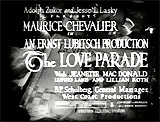


The Love Parade (1929), D: Ernst Lubitsch
Lubitsch's first talkie-sound film (adapted from the little-known Hungarian play The Prince Consort), was the first filmic musical. The witty and bubbly film, a fashionable operetta, exhibited the director's creative adaptation to the requirements of sound film, and was one of the first backstage musicals with musical numbers that were integral to the plot. Smoothly directed, Lubitsch avoided making it stage-bound and over-acted like many of the early talkies. The film featured the delightful pairing of singer Jeanette MacDonald (in her first film, debuting as the frustrated, red-haired Queen Louise of the never-never land of Sylvania) and the film's sole star Maurice Chevalier, a French cabaret performer in his second sound picture (as womanizing military attache Count Alfred Renard and MacDonald's consort/prince). The couple were married although unhappily with his powerless role as spouse. He was persuaded not to divorce, and the couple eventually learned to compromise. This film combined Lubitsch's sophisticated touch, sexual innuendo, songs integrated into the storyline, and such delightful and lilting numbers as "Dream Lover" (sung by MacDonald as she drowsily awakened in a sleekly revealing negligee once more without a man), their duet of the title song "My Love Parade," and Chevalier's entertaining singing of "Anything to Please the Queen." He also sang "Nobody's Using It Now" (about his tribulations after being married and finding himself virtually castrated as the Prince Consort). It received six Academy Award nominations.


The Man With a Movie Camera (1929, Soviet Union) (aka Chelovek S Kinoapparatom, or Человек C Kино-Aппаратом), 68 minutes, D: Dziga Vertov
Soviet writer/director Dziga Vertov's masterpiece was a quintessential experimental, avante-garde film and an excellent example of a "city symphony" documentary. It was regarded as "pure" visual cinema of everyday life without a plot, action, setting or dialogue (or intertitles) - it was literally a day in the life of the Soviet Union (although filmed over a four-year period), shot with the camera slung over the photographer's shoulder. Its views of Moscow, Kiev, Odessa and of Soviet workers and machines contained radical hyper-editing techniques, variable camera speeds, dissolves, special visual effects, wild juxtapositions of images, freeze frames, split-screens, and super-imposed double exposures.




Pandora's Box (1929, Germ.) (aka Die Büchse der Pandora), 97 minutes, D: Georg W. Pabst
G.W. Pabst's classic silent film melodrama, an early erotic and hypnotic work, produced hateful critical reviews for its overt sexuality. Throughout the film, Louise Brooks portrayed a tempting goddess named Lulu. She was an insatiable, free-spirited, 18 year-old cabaret chorus girl and femme fatale with a black bob (pageboy) haircut. She was caught backstage in a wardrobe room scandalously kissing her obsessed and spell-bound patron - a wealthy newspaper owner named Dr. Ludwig Schon (Fritz Kortner) - by his more socially-acceptable fiancee Charlotte Marie Adelaide (Daisy d'Ora). During Dr. Schon's subsequent wedding party, virginally white-dressed (inappropriately), bi-sexual and amoral bride Lulu engaged in an intimate, flirtatious tango with black silken-dressed, chic lesbian aristocrat Countess Anna Geschwitz (Alice Roberts). After the ceremony and party, bridegroom Dr. Schon became enraged with jealousy at Lulu (for her starry-eyed flirtations with his son Alwa (Franz Lederer)) and thrust a gun at her, crying: "Take it! Kill yourself!...so that you don't drive me to murder as well." He was accidentally murdered during a struggle for the gun between them. During the subsequent trial for manslaughter, the hedonistic Lulu (wearing a black veil) was accused by the prosecutor of being like a Pandora's box of evil. She met her destiny during the expressionistic finale on Christmas Eve as London Soho prostitute Lulu became another gleaming-knifed victim of Jack the Ripper (Gustav Diessl) during an erotic embrace and kiss (her hand went limp to indicate her death) - after the knifeblade was stuck into her stomach - off-screen.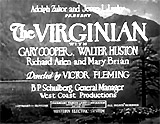

The Virginian (1929), 95 minutes, D: Victor Fleming
A western film and adaptation of a pulp novel. The story of the conflict between a Wyoming ranch-hand foreman, the Virginian (Gary Cooper) and a group of outlaws who were changing brands and rustling cattle. Walter Huston played Trampas, the villainous leader of the gang, who met his end in a dusty street shootout/showdown with the Virginian. The film was most memorable for a very early scene at the bar of a saloon. Insulted by Trampas' words: "If I wanna know anything from you, I'll tell ya, you long-legged son of a ---," the Virginian (Gary Cooper) responded by quick-drawing his gun and threatening Trampas with his pistol pressed against his abdomen: "If you wanna call me that, smile." Trampas grinned: "With a gun against my belly, I-I always smile."